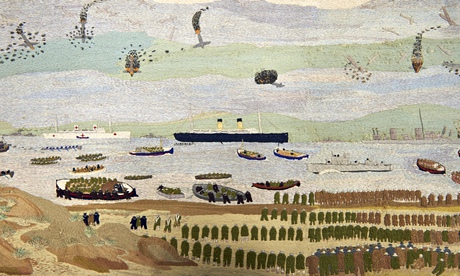
One day, not many years ago, the writer Julia Blackburn was talking with a painter friend called Emily. “What about John Craske?” offered Emily. And so it was that Blackburn found the subject of her new book, a biography that shades first into memoir and then into something much more complicated. How to describe it? “Meditation” is too pompous, and it would be rather obvious to call it a tapestry, given that so many of its pages are devoted to stitching. Perhaps I should just be honest. While I was reading it, I thought of Threads as an exquisite notebook, with all the mystery that implies. It couldn’t simply be read. I felt I had to decipher it: to peer at it, magnifying glass in hand.
All books begin with a stray thread; the writer pulls, and waits to see what will happen. The thread on which Blackburn yanked was a now mostly forgotten Norfolk fisherman turned artist: John Craske. Born in 1881, he went to sea at the age of 11, but as a young man worked mostly in the fish shop where he and his devoted wife, Laura, smoked haddock and kippered herring. In 1917, however, he fell ill while training with the army, and after this his life changed for ever. Until his death in 1943, Craske would slip in and out of what was described as a “stuporous state”. Sometimes his condition was so extreme he seemed hardly aware of the world around him. At others, he bobbed nearer the surface, able to talk and listen and work with his hands. No one knew the cause of his illness. Blackburn discovers that he had diabetes, but she also talks to a doctor who convinces her that Craske suffered badly from some kind of mental disturbance, his nerve storms as perilous as those out in the North Sea.
Marooned in his tiny house, Craske began painting, covering every available surface with images of boats and the briny water. Later, he turned to embroidery, too, stitching even as he lay in bed. Like Alfred Wallis, the Cornish fisherman-artist who was taken up by Ben Nicholson, Craske’s work – as Blackburn notes, his swelling waves and tilting boats seem to capture not only the precariousness of the sailor’s life but of human existence itself – now drew the attention of influential people: in his case, the poet Valentine Ackland and her lover, Sylvia Townsend Warner. Thanks to them, Craske’s work was exhibited in London and New York. After his death, Warner donated her collection of Craskes to the tenor Peter Pears, as a result of which they now belong to the Snape Maltings arts complex in Suffolk. Other Craskes can be found at the Glandford Shell Museum near Blakeney, and the Castle Museum in Norwich, which owns Craske’s unfinished embroidery of the Dunkirk landings – a wondrous depiction that grows all the more marvellous when you learn it was inspired by reports on the wireless.
Blackburn is stirred by Craske’s story but she isn’t sure what to do with it. She has so little to go on. Trying to find out more involves her in some odd encounters, each one of which she carefully describes, not always certain of its relevance, but working on a hunch that it will all make sense in the end. Here she is in Great Yarmouth, talking to a woman whose circus grandfather “discovered” the Elephant Man. And here she is on board a boat called the Sea Quest, trying to learn about fishing from a man called Paul whose Goan wife did not know how to make a sandwich when they first met. And here she is copying down a recipe for beef tea that she finds in the teddy bear-filled house of the grandson of the doctor who treated Craske in exchange for the tiny paintings that even now fall from the pages of old books like strange confetti.
Her quest brings out in her a gentle but stubborn curiosity – and how it pays off. She asks a friend if she might introduce her “to a philosophic fisherman”, the better to get inside Craske’s head, and the friend obliges with a man called Keith, who tells her that 14 days out on a trawler from Grimsby he would eat six dabs for breakfast. He also provides her with a list of seafaring words Craske would have known, and thus she learns that the water is in a “brabble” where the currents cross its surface, that a tide “runs hot”, and that fresh herrings are brought to land in wooden baskets called scutcheons.
Unwittingly, she is compiling a kind of oral history of the Norfolk coast, only without the dreary sociological silt that term implies. Every encounter, every voice, is distilled into something close to poetry, whether sad or comic, and then woven deftly into what came before. The Norfolk giant, Robert Hales, appears, and so, too, does Albert Einstein, who spent three weeks living in a hut on the coast while on the run from Nazi Germany. The stories seem to roll in, like mist.
Somehow, though, John Craske never falls out of sight. Blackburn makes him so vividly alive, you can almost hear him: his low voice, his rasping breath. Grief suddenly invading her own life, he becomes a proxy for something lost. Memorialising him is both a tribute and an act of avoidance; a means of paying testament to the balm that is work, whether for ailing fishermen or mourning writers. Oh, what a miraculous book this is: parochial, weird and inconclusive in a way that few books dare to be these days, and illustrated by its publisher so very generously, with something beautiful or interesting to look at on every other page. Buy it, and let it take you out to sea, no sou’wester required.
Threads is published by Jonathan Cape (£25). Click here to buy it for £20

